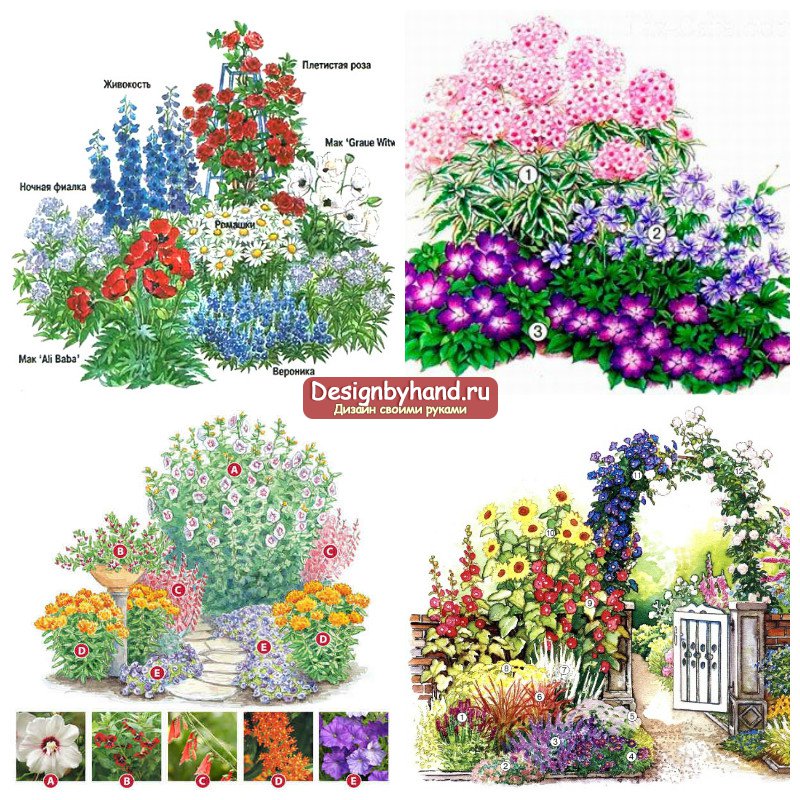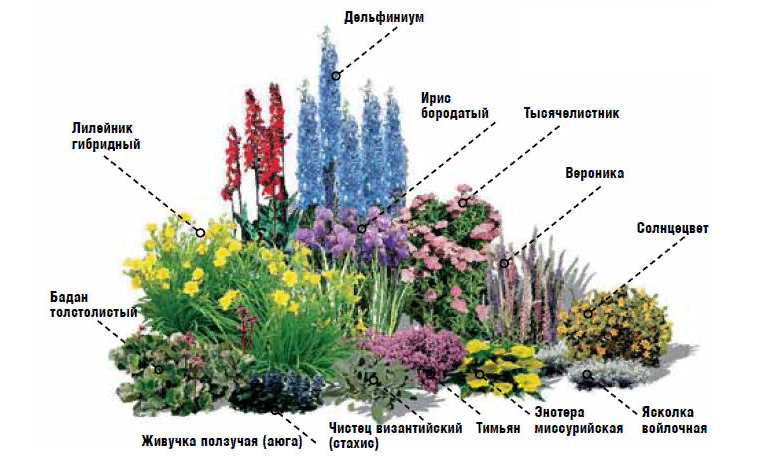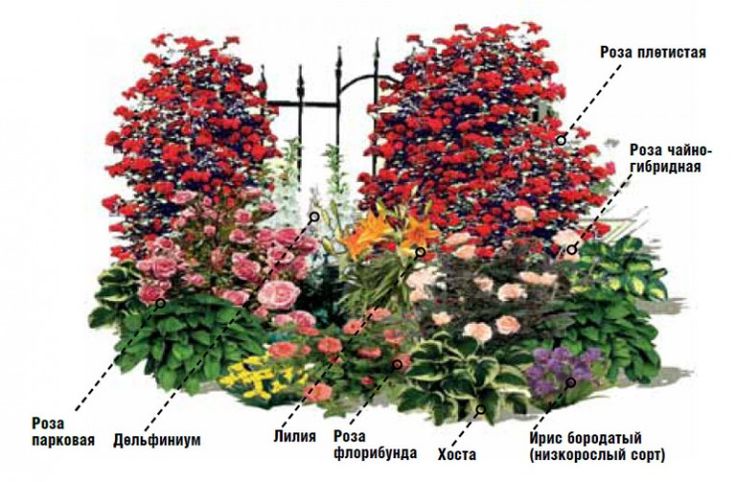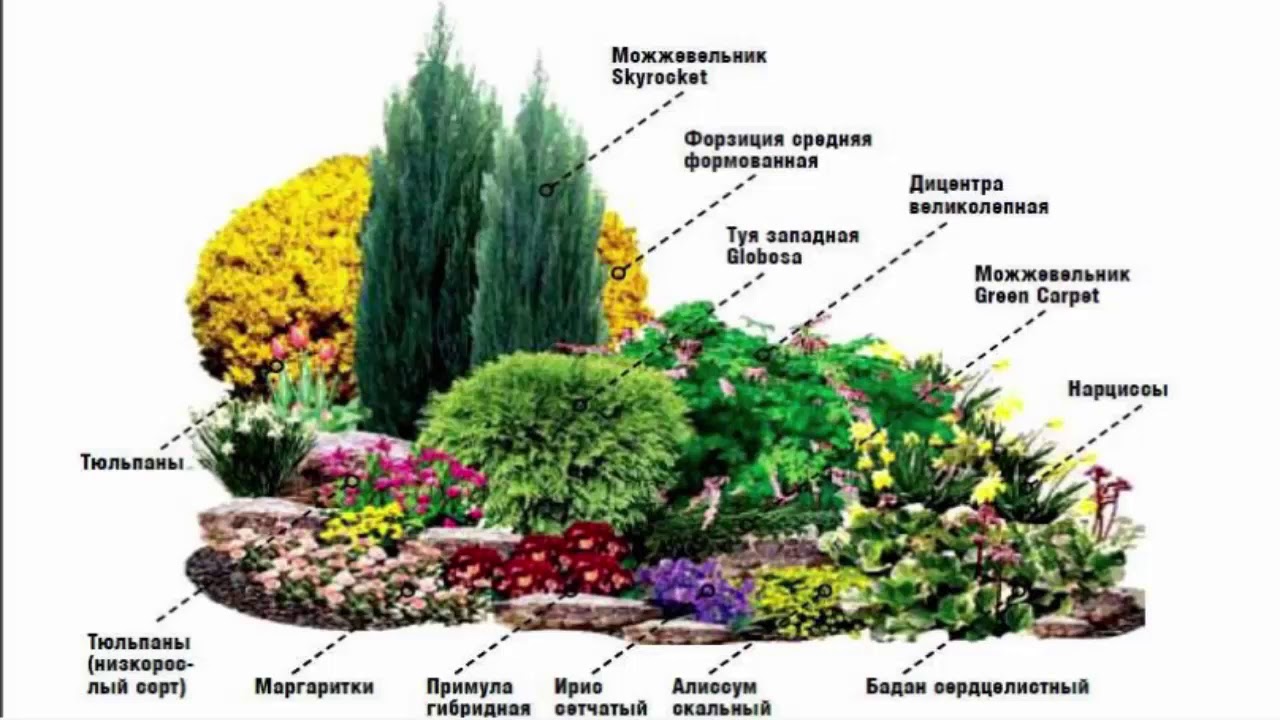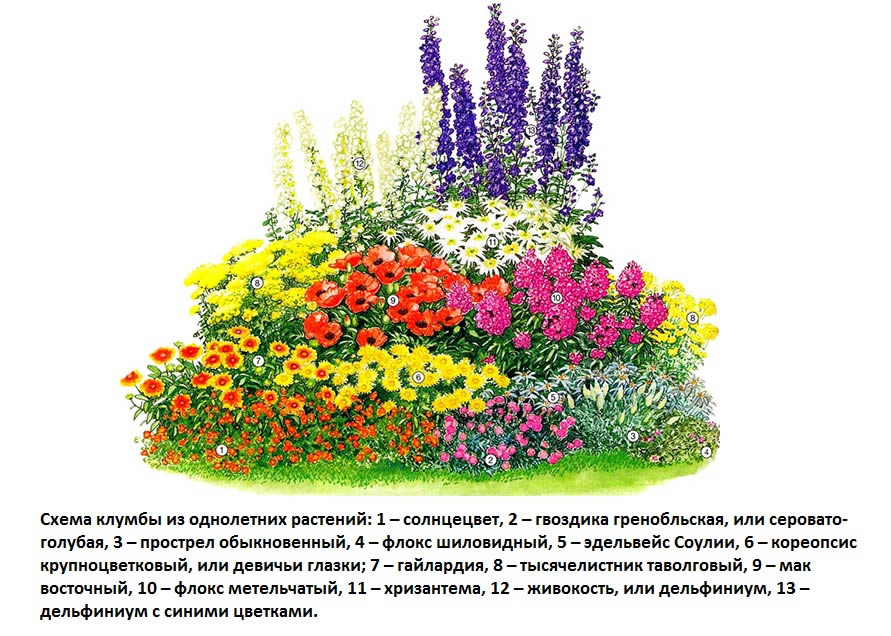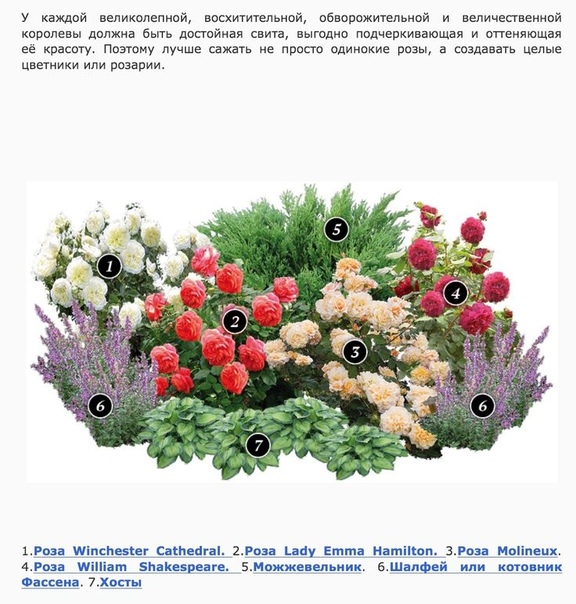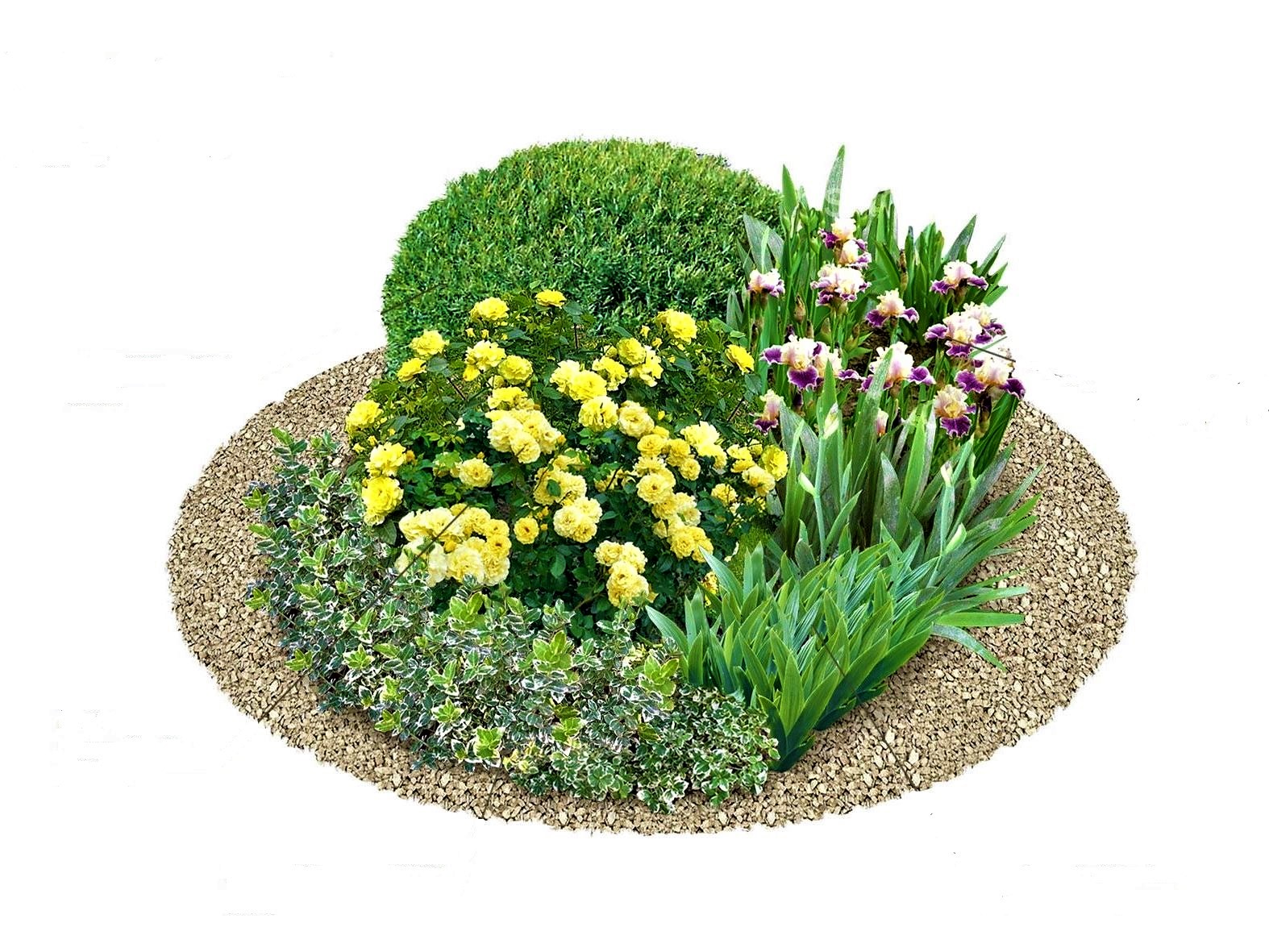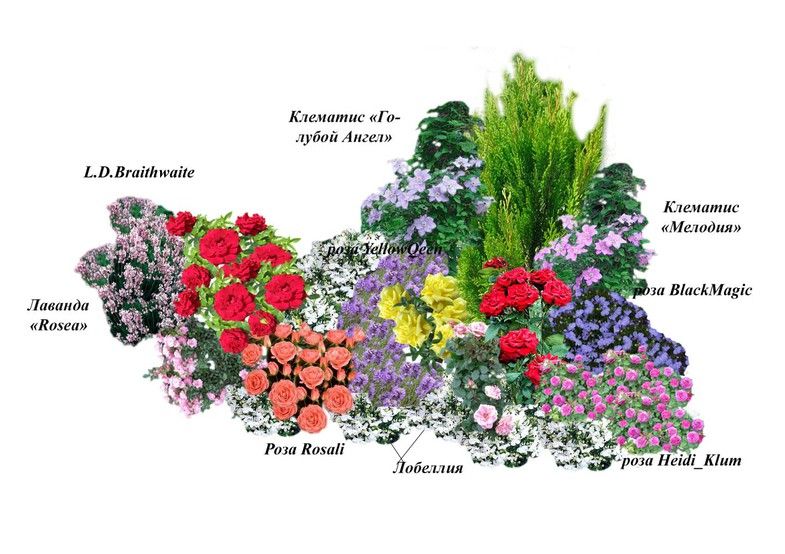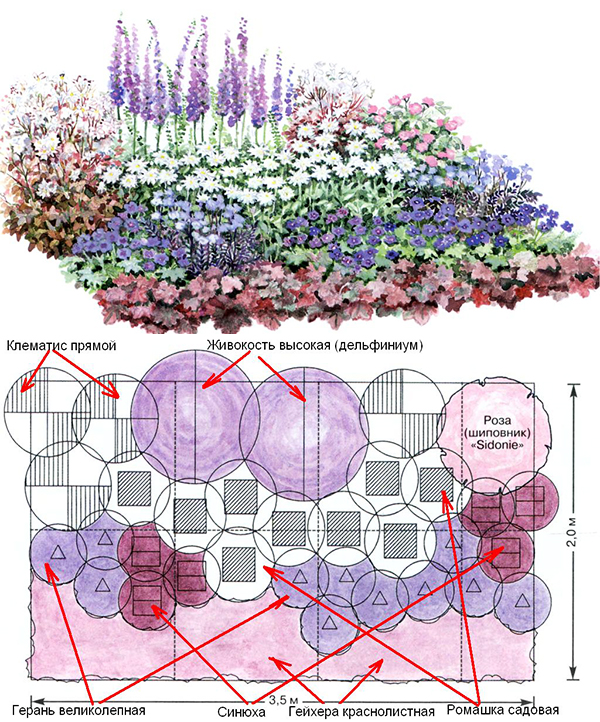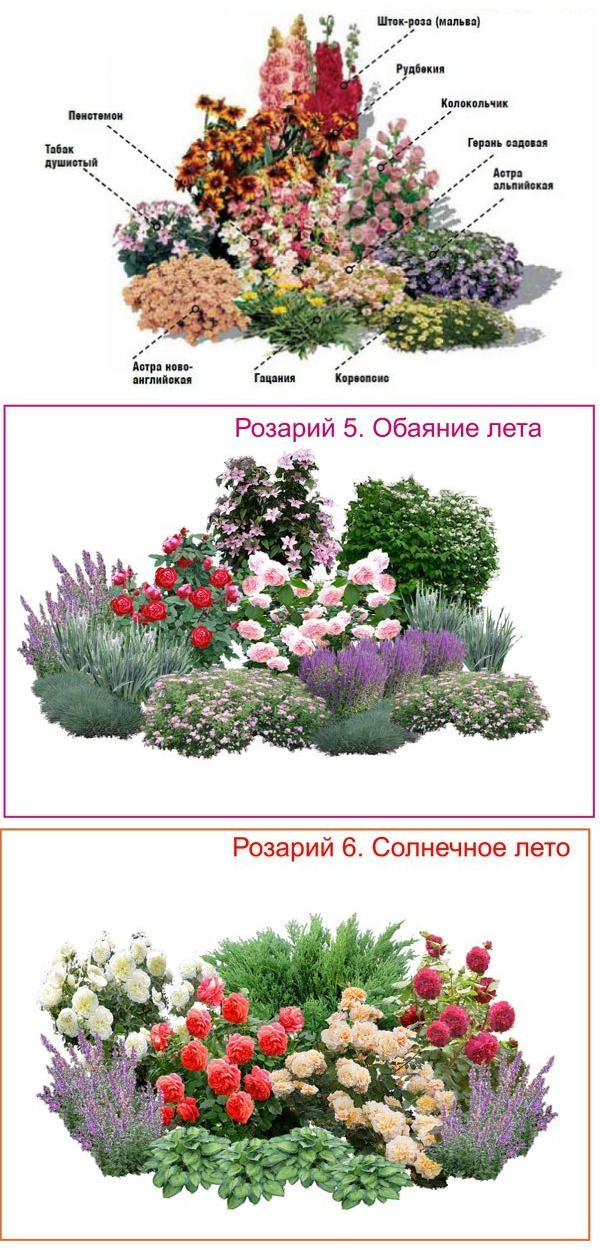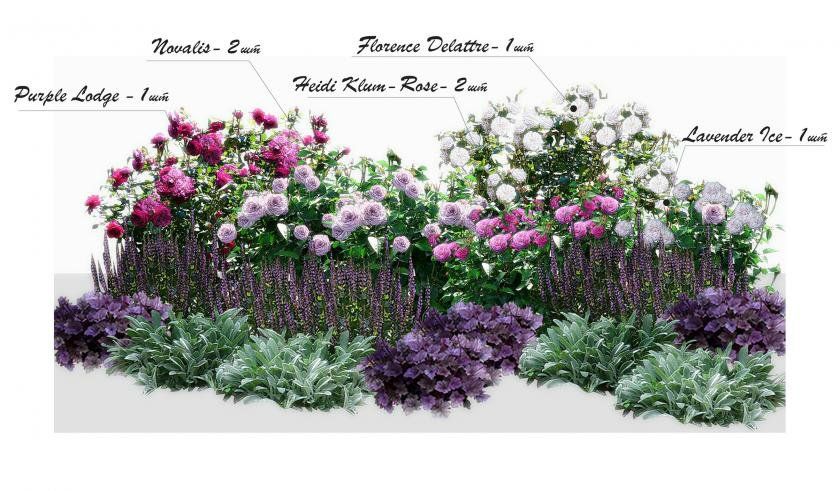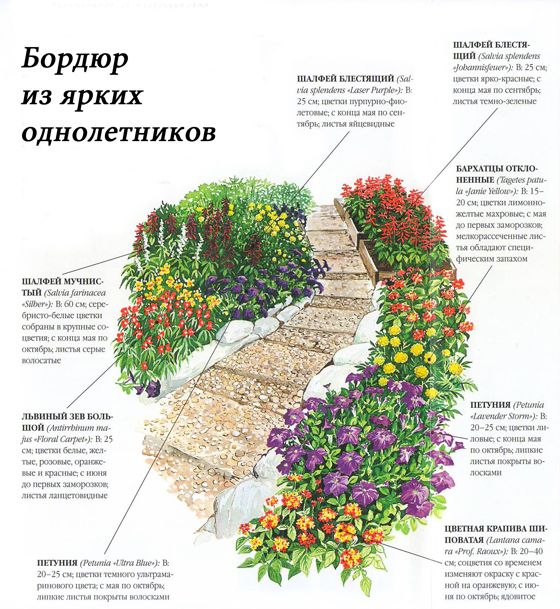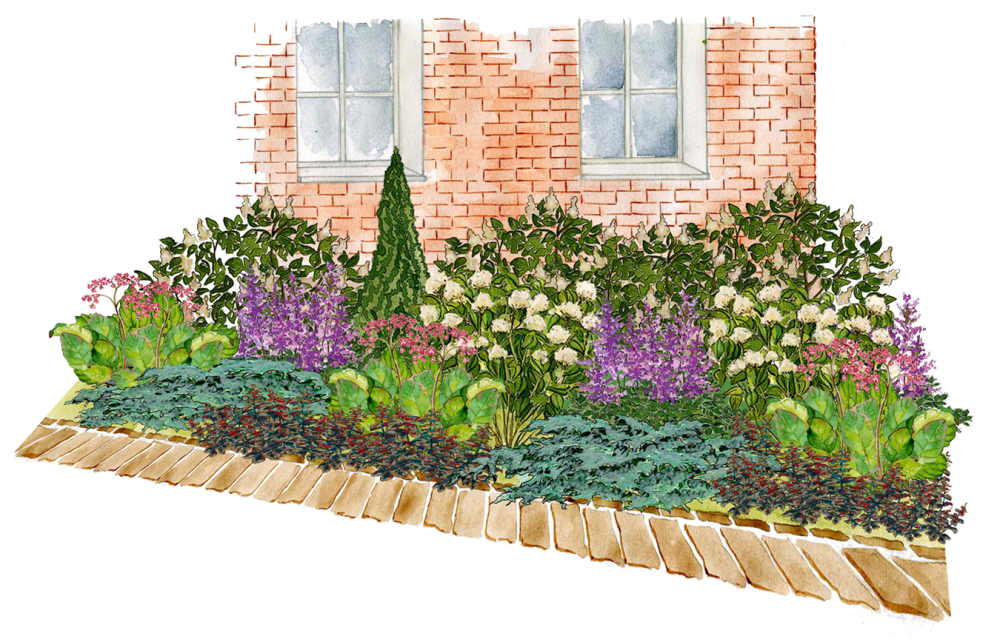The queen of flowers in landscape compositions
Roses are one of the finest and most popular flowers in the garden. How to correctly combine roses with other plants, not minimizing, but emphasizing their beauty?


Here are some tips for creating a composition featuring the queen of flowers:
When planting, it is better to surround flowers not with other flowers, but with greenery, which will create the desired background without distracting attention to itself. Planting several varieties of roses next to each other is wrong.
It is better to surround it with more modest neighbors or place many plants of the same variety nearby. Large flowering shrubs should not be planted next to the rose, they will distract attention. The best option is a small bush with silvery leaves. Roses look good next to evergreens. Among them, it is better to choose low spruce, fir, pine. Roses in such a composition are soloed, the needles give the flower a special sophistication, exclusivity, serves as a wonderful background, emphasizing its rare beauty favorably. In the vicinity of box trees, the rose looks like a highlight. This combination is very common in European rose gardens, with box trees being given the most varied forms. For the winter, this shrub must be wrapped along with rose bushes, because he does not like low temperatures.
Drawing up landscape compositions is a whole science, which includes floristry, color, allelopathy, agrochemistry, aesthetics and others. We recommend reading the article on the prairie garden.

But a living picture should still please with a change of colors, create a positive mood, help to relax and unwind.
Therefore, landscape design, taking into account all these and many other features of wildlife, is so important for everyone. You can read the article about the features of the country-style site design.
Features of landscape design with roses
Much depends on the terrain and type of terrain. With the right approach, on any site, you can create an original composition. Large and small stones, a small pond or river, lowland or meadow - all this is a space for creativity. But when planning a summer cottage, one should take into account, first of all, climatic features, soil type, presence or absence in the immediate vicinity of reservoirs, plantings.
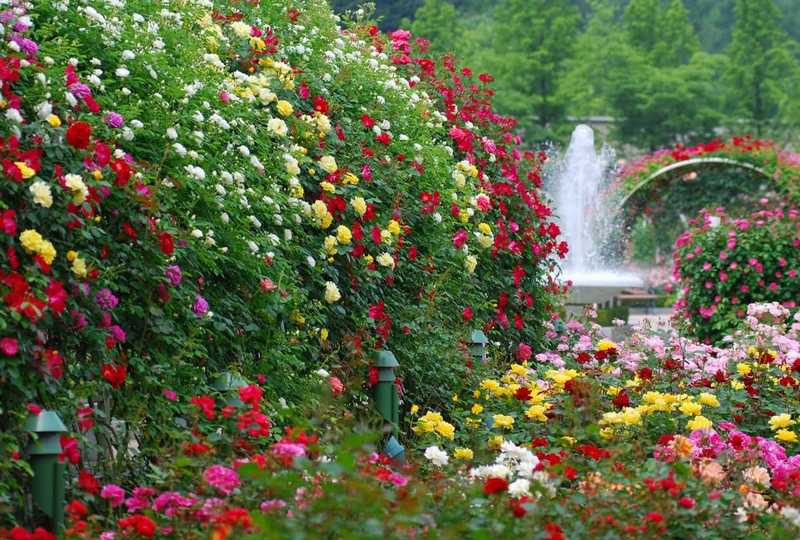
Roses in the garden in landscape design
Modern trends in landscape design present solutions such as a multifunctional or compact mini-garden, a dining room in the courtyard in the open air or with transparent glass walls, and flower beds with exotic plants. The Scandinavian design, which is distinguished by its simplicity, which is achieved through comfortable and natural things, remains so popular.
An invariable classic is the presence of a rose garden on the site - flower beds with roses. Roses on the lawn look like a lush, flowing bush and are a real decoration of the garden. Often several bushes with roses are planted at once, complementing the composition with arches. Such islets look very beautiful on the alleys along the paths.
Roses in landscape design are used both in spacious and in small areas.
On a note! Climbing roses, when properly cared for, form a wonderful hedge.
To equip such a fence, tall varieties are selected, a strong arch is installed from improvised materials. When the plant begins to stretch, it is given a direction and thus a wall of flowers is formed.

Hedge of roses
Recommended color combinations
To make the flower bed look harmonious, you should think it over to the smallest detail. In this case, it is recommended to take into account color combinations.
Elegant and soothing
To make the plantings look elegant and at the same time have a pacifying effect, it is worth using white or green roses. The varieties Bolero, Mont Blanc, Iceberg look great.
In pastel colors
For this, roses of cream, lilac, white tones are suitable. Light pink flowers look great. The varieties Novalis, Elina, Flamingo are considered suitable options. It is permissible to plant Pomponella, Helena plants.
Bright
To make a rich flower bed, you should use yellow, purple, red roses. Orange flowers are a great solution. Popular varieties include Masquerade, Arthur Bell, Casanova. Monica and Gloria Day look no less good.
Contrast
To design such a flower bed, 2 colors are used that are in harmony with each other. Red and white roses go well together. The combination of yellow and purple varieties looks no less successful. Plants Black magic, Cardinal, Cherry look good.

Unusual
In this case, you should use pastel shades of roses in combination with bright accents. Plants of delicate flowers can be combined with bushes that are decorated with purple, crimson, orange petals. Recommended varieties include Chopin, Ingrid Bergman, Cherry Brandy.
Description of planting roses for garden and summer cottages
Preparing a beautiful design of a flower bed with your favorite plant on your own is not as difficult as it seems at first glance, the main thing is to know the important principles of installation and the rules for combining various species and varieties of plants. As an integral part of the garden plot, the rose is too versatile - it can be both the main one in the flowerbed and aesthetically pleasing to other, brighter plants.
In order to determine for yourself how best to arrange a flower bed, experienced gardeners advise you to choose a plant variety first. Then you can choose a design.
| Type of flower bed | Description |
|---|---|
|
Blooming border |
The simplest type of flower bed... Best suited for the novice gardener. To delimit such a flower bed, varieties growing in a bush method are planted along the path. For a beautiful installation, you can alternate with hybrid tea varieties. Planting roses of this type can be either staggered or continuous. |
|
Mixborder |
A flower bed with many different varieties of plants. With this type of garden decoration for the queen of flowers, “neighbors” are carefully chosen. It's all about the flowering of plants - it does not have to coincide in time. Lanky flowers are planted in the back row, medium varieties with long flowering are selected in the center, and the smallest ones, with a spectacular look, are brought to the fore. |
|
Structural rose garden |
Most often, designers recommend this option for landscaping ponds, gazebos, arches, etc. Weaving varieties of roses, which effectively wrap around the walls of arbors and arches, can cope with the presented task without any problems. For ponds and other bodies of water, miniature bud-like varieties are best. For exclusive landscaping, roses are considered indispensable varieties without side shoots (standard). |
|
Flowerbed on a slope |
The best way to fill a garden spot that is not suitable for planting many flowers. The main principle of the composition is to use ground cover plant species, combining them with spreading flowers (ivy, phlox, moss). Together with each other, they will present a rich blooming carpet to the human eye. |
|
Hedge |
In the longitudinal direction of a hedge or an architectural wall, experts advise planting bushes of tall climbing plant species in a checkerboard pattern with an interval of up to half a meter from each other. In between, plants of a miniature size of the corresponding color palette are usually planted. |
Companion roses
Roses have a special place in landscape design, but no matter how beautiful a diamond is, it needs a decent setting.
The beauty of roses is ideally revealed against the background of conifers, which can make up the background of a flower garden.Compositions with barberry are good, its red foliage and bright fruits are spectacular when the roses are already fading. From shrubs, skumpia, cotoneaster, yellow acacia, euonymus, privet, tamarix, vesicle and others are also suitable. Aristocratic combination of roses with evergreen boxwood.
In spring, the gaps between the bushes will be decorated with delicate bulbous and other primroses. Early flowering varieties of peonies will enrich the spring composition.
Roses and lilies in the flowerbed complement each other well; these flowers have different periods of activity. The queens of the garden are beautifully combined with herbaceous plants that have a blue-lilac shade of inflorescences, for example, irises, bells, lavender, periwinkle, blue and white phlox.
Compositions of roses with plants with candle-shaped inflorescences, such as delphiniums, veronica, aquilegia, leatrice, foxglove, are interesting.
Plants with silvery foliage, such as cineraria, silvery wormwood, woolly stachis, and silvery elk, balance the diversity of the flower garden.
A wonderful partner for a rose is clematis. It can be paired with garden queen climbing varieties and can also be used as an accent in a flower bed. But you need to plant clematis after the rose gets stronger, since the strong root system of clematis can suppress the young neighbor.
All kinds of decorative cereals successfully set off the sophistication of roses. They also look original together with flowering bows.
The unattractive lower part of the rose bushes will be covered with their beautiful foliage by brunners, abundantly blooming forget-me-nots, sea lobularia, alissum, as well as heucheras, the variety of species and varieties of which will surprise even experienced gardeners.

The combination of roses with spicy plants (sage, mint, thyme, basil, lemon balm, parsley, tarragon, marjoram and others) is unusual and quite attractive.
If your roses grow in openwork partial shade, then all kinds of hosts will be wonderful companions. An ostrich can be a wonderful neighbor - although it is a fern, it feels great even in sunny areas.
As you can see, a flower bed of roses with your own hands is a very real thing. You only need to have a great desire, and our advice will help to translate this desire into reality and avoid many mistakes.
Vertical design
In landscape design, there are many techniques for creating amazing compositions. Vertical gardening gives the surrounding space depth and makes it unique.

If a person is interested in the question of how to arrange a rose garden in the country, then it is worth listening to the opinion of experts. Such a composition often performs not only a decorative function, but is also used for practical purposes.
In a small area, this method will make it possible to place more plants. If the building has some flaws, then they can be hidden with the help of lush vegetation. A curly rose with luxurious flowers will decorate a gazebo, wall of a house or a fence.

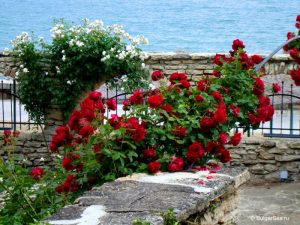
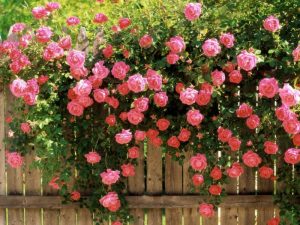

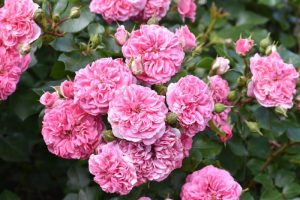

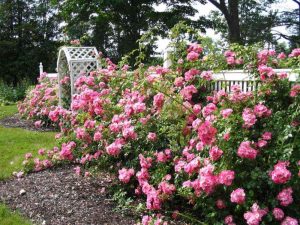

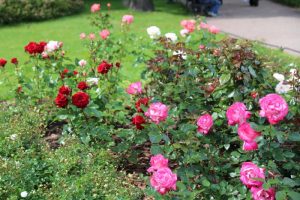
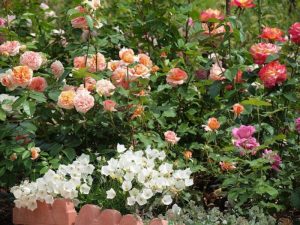


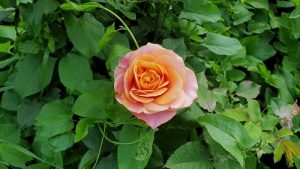


Characteristics of the color scheme in the flower bed
All shades are divided into warm (yellow-red gamut) and cold (violet-blue palette). Warm colors visually make the object more voluminous and, as it were, bring it closer, while cold colors, on the contrary, reduce and move away. This property can be actively used when creating the perfect flower garden.
Red is a very rich color, it is considered cheerful and optimistic. But under the influence of bright sunlight, red objects "cut" the eye and therefore appear flat. But in cloudy weather they become more expressive and deep. Therefore, plants with red flowers and leaves are ideal for northern regions, where cloudy days are frequent in summer.

Yellow, golden orange and lemon colors draw attention to themselves, create accents in the garden and uplift the mood
They are able to paint even a dark corner of the flower garden, however, it is important not to overdo it with these shades, otherwise they will overshadow the neighboring plants.
Blue, purple and blue shades give the flower garden depth and romance
The colors of the sea and sky are great for relaxing and energizing. These shades help relieve stress and irritability.
And you also need to remember that blue and purple tones located in the background visually enlarge the flower garden. To achieve harmony, it is recommended to use yellow and red tones in the foreground. This will visually bring the distant plan closer.
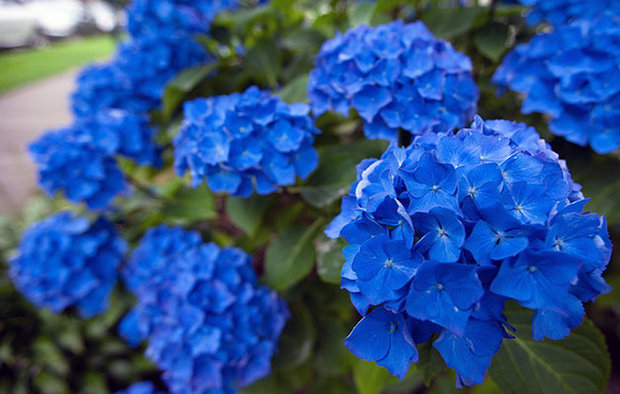
- White is also considered a romantic color. Moreover, it is universal and can be used in any flower beds. White helps to bind incompatible shades and make smooth transitions between them. In addition, white looks good in the shade, as well as in all corners of the site in the late evening. The same functions are performed by gray and silver shades.
- Green color perfectly soothes and smooths out irregularities and abrupt transitions. The more green shades in the flower garden (lawn, plants with large green leaves), the more tones (including contrasting ones) can be used, since the green color mutes the flashy shades.
The flowerbed should be dominated by blue, purple, white, pink and green tones. They will serve as a beautiful background. And saturated shades (red, orange, yellow) are best used sparingly (in small groups of plants). In addition, a very bright and contrasting color spot (consisting, for example, of lemon, red, blue crimson and orange flowers) should occur no more than once in the flower garden.

A flowerbed, which you will admire from a distance, is best decorated in contrasting shades, and a flower garden, located, for example, near the house, is advised by landscape designers to be kept in the same color scheme. Monochrome gardens look great here.
Simple flower beds
Simple flower beds are made flat in the form of a geometric figure, more often a circle or rectangle
You can create flower beds in the form of an oval, rhombus or any polygon.
When forming a simple flower bed, it is important to take into account that when planting from seeds in the first year, only annual plants will bloom, and then some bloom only after 13-15 weeks. Therefore, it is more convenient to plant many flowers through seedlings.
Flower beds are often made from 3 to 6 meters in diameter. Make a small mound of soil, the flower bed should rise and be visible. A round or oval flower bed can be given with a rope, the sides of rectangles or polygons are measured with a ruler. In order to separate the flowerbeds from the lawn and protect them from overgrowing with grass from the garden, they are fenced with bumpers or decorative rubble, poured onto a black film.

- Mark an area with a diameter of about 2.5 meters.
- Place a boulder in the center.
- Plant several bushes of peonies or low-growing irises of different shades around the boulder, or 10 pieces of zinnias.
The so-called irregular flower beds are ideal for beginner gardeners. Such flower beds do not have to be planted in a strictly defined shape or size, flowers can be planted in different heights, observing only the rules for the location and combination of colors. You can pick up plants that bloom at the same time or in turn.
Examples of ready-made solutions
Irises look attractive. They look interesting in single plantings or stand out against the background of other plants. On cultural sites, it is permissible to plant in the following ways:
- Along the paved garden paths. Such cute plantings are called ridges. Flowers can be planted on one side of the path or on both sides.
- In mono flowers. Crops are allowed to be planted in flower beds of different sizes. Moreover, they are made from the same colors of one or more shades.
- Near reservoirs. Irises can be planted on the shore or in swampy areas.Some types of flowers thrive in shallow water.
- In the rock gardens. Flowers look good with conifers. The combination with dwarf pines or Christmas trees looks spectacular. Even after the end of the flowering period, the composition will retain its excellent decorative properties.
- In mixed beds. Such plants stand out exquisitely in combination with different flowers and ornamental shrubs.
When placing irises in one area, be sure to take into account the size of the plants of a particular variety. It is worth planting low crops in front, and higher crops in the back.
Irises are beautiful ornamental plants that can decorate any flower bed. They are recommended to be planted separately or combined with other flowers. To get a beautiful composition, it is recommended to think it over to the smallest detail.
Share link:
How to plant roses in a flower bed with other flowers
The most important thing when creating a flower garden is to correctly draw up a diagram. After all, you need to take into account the botanical features of any flower.
It is important that the rose is not deprived of sunlight and nutrients contained in the soil. The layout of the flower bed should be done in detail.
- Rose and tulip. The tulip is a bulbous plant that protects the rose from possible diseases. They grow quickly, so you need to keep the distance when planting (about 30 cm).
- Rose and iris. Irises are bulbous and rhizome. The second type is very fond of light, so a struggle with a rose for a place in the sun is possible. Excess fertilizer damages rhizome irises. Bulbous irises should be regularly cleaned of yellowed foliage and wilted flowers.
- Rose and host. Hosta is a low-growing plant, practically not blooming, but having a decorative appearance due to leaves of various shades with edges and stripes. Can be planted under a rose to create edging.
How to make a mixborder with roses and other flowers
How to plant roses in the country is beautiful, - perhaps every gardener who grows flowers would like to know. A mixborder with roses and other perennials is a great option even for a small summer cottage.
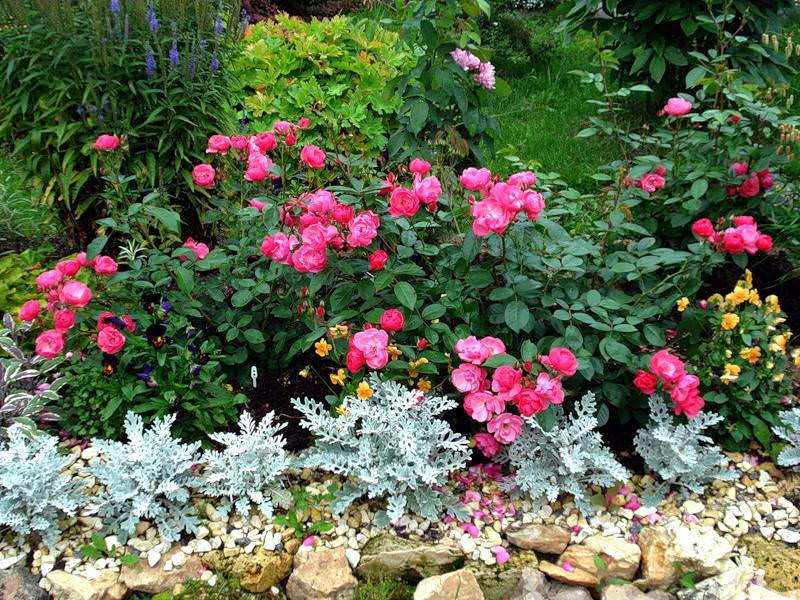
Mixborder with roses and other flowers
Important! Mixborders are built to show the beauty of a wide variety of colors in one "package". The design of a hedge of roses in a mixborder can be harmoniously complemented by clematis, red-leaved shrubs
It is advised to mix no more than 6-7 plants. When creating a mixborder with roses, it is better to focus on them. You can choose either one type or several at once - park roses, climbing, spray or standard
The design of a hedge of roses in a mixborder can be harmoniously complemented by clematis, a red-leaved shrub. It is advised to mix no more than 6-7 plants. When creating a mixborder with roses, it is better to focus on them. You can choose either one type or several at once - park roses, climbing, bush or standard roses.
The color combination of roses in the rose garden plays a special role. Contrasting shades look advantageous:
- yellow + red;
- yellow + brown;
- white (gray) + pink;
- blue + silver (white);
- yellow + magenta;
- blue + yellow;
- green + blue;
- purple + white (silver);
- red + pink;
- red + blue;
- pink + yellow;
- blue + orange.
Four complex design schemes
We have already considered the simplest scheme for planting flowers in a flower bed. Now let's look at schemes for several more complex flower beds.
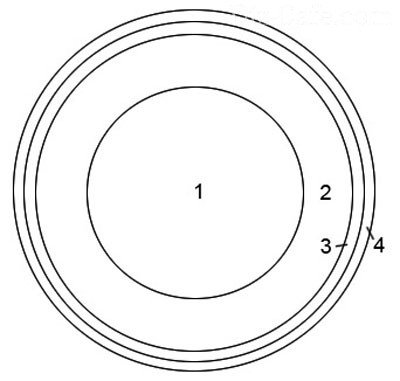
Round flower beds are usually central. If you have a large free area in front of the house, creating a round flower bed on it will allow the area to look elegant. Use plants that bloom at the same time, in spring they can be bulbous, then they can be replaced with summer flowers
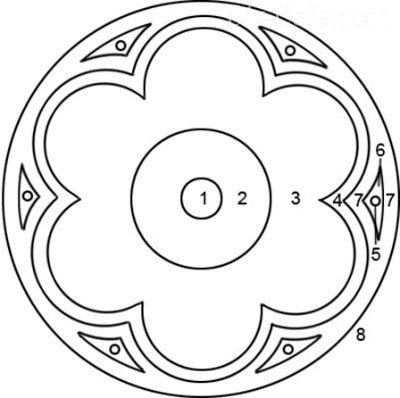
The "flower" scheme for creating an elegant flower bed.Depending on the size, the central part can be occupied by lawn grass, ground cover plants, a layer of gravel or colored decorative sawdust.
All schemes have a common point - the middle space is occupied by lawn grass, that is, these are rather large flower beds. If you want to use this pattern to create a small flower bed, the lawn can be replaced with ground cover plants, which are ideal for creating patterns. As plants for such flower beds, flowers that bloom at about the same time are suitable - daisies, zinnias, Alpine forget-me-nots, primrose, viola, levkoi.

The "pattern" scheme will allow you to create an original flower bed, a wave-shaped pattern can also be an independent flower bed on the lawn or along the paths

Oval "royal" flower bed. Its layout is simple, but it will look great as a front flower bed in front of the house or in the center of the garden.
When you create a scheme, you need to think about the colors and shades that you want to see in the flower garden. Color combinations in a flower bed can be very diverse. There are no clear recommendations on the choice of plants for these flower bed schemes, you can choose where to plant your favorite flowers, how best to combine them with each other.
Types of roses
There are many varieties of roses, each of which has certain characteristics.
Shrubs
These are common plants that need light and fertile soil. Cultures need good lighting. For abundant flowering, systematic feeding is required.
Park
Such roses are considered unpretentious. They do not require pruning and are not afraid of frost. New crops are resistant to diseases and pests.
Hybrid tea
When growing such roses, problems arise. They grow well in greenhouse conditions. At the same time, in the open field, sparse and rare flowering is possible.
Floribunda
This variety was obtained by crossing hybrid tea and polyanthus crops. With adequate care, roses bloom profusely.
Curvaceous forms are characteristic of these cultures. It is permissible to combine them with low perennials or a beautiful lawn.

Climbing
These roses are great for vertical surfaces. They are used for draping walls, trellises and trees.
Groundcover
These roses are characterized by arched shoots and fragrant flowers. When growing ground cover roses, you can get a dense carpet.
Rules for drawing up flower arrangements
Visiting floristic exhibitions, people are amazed at the imagination and talent of the masters who create real masterpieces even from ordinary-looking plants. Composing an exquisite flower arrangement requires not only ability and inspiration, but also knowledge of the basic rules of floristry.
Before you start creating a flower bed, you need to draw or draw up a project in your mind, and based on it, perform a composition. A flower with a contrasting shade to the main background is usually chosen as the main point.
Imagining how a flower bed should look like, they divide it into 8 parts of the same size.
To make the composition look bright and interesting, plants of different heights and colors are used.
The bouquet seems weightless if light tones are combined, dark ones make it heavy and lush. To add harmony to the flower bed, you need to choose the right colors. The palette should be discreet, not flashy. The shades of the same paint are always successfully combined, contrasting tones look good in a certain sequence, starting with red and orange, and ending with blue, purple.
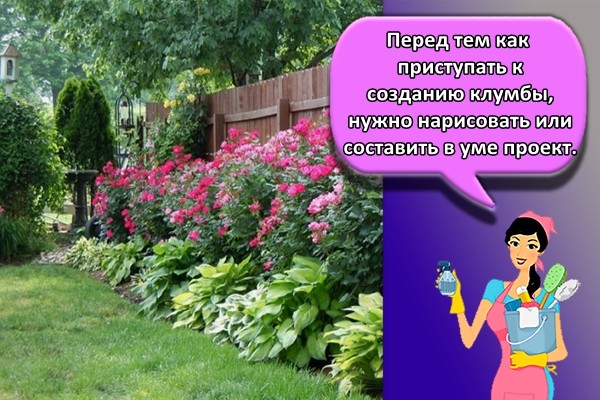
Features of caring for a flower garden
In order for irises to grow and develop normally, it is recommended to properly care for them. These flowers need sufficient light and moisture.
It is especially important to water the plants during the budding stage. Subsequently, it is worth moistening the soil only when it is completely dry at the roots.
Many gardeners are sure that flowers can hardly tolerate a transplant.However, in reality this is not the case. It is recommended to divide the bushes immediately after flowering. To do this, you should carefully dig out the roots so as not to damage them.
Timely weeding is also important. It is recommended to remove weeds manually
This is due to the structure of the root system - it is on the surface. It should be borne in mind that irises are susceptible to various diseases and pests. Therefore, it is worth monitoring the development of plants during the growing season. If signs of rot appear, it is recommended to get rid of the infected plant and spray the neighboring bushes with Fundazole solution. The same tool is recommended to process the rhizomes before planting. This will help minimize the risk of developing disease.
Correct color arrangement
Coloristics - competent planning of color combinations on the site is of no small importance. With a large range of colors present in the garden landscape, it is important to maintain the measure and not to overshadow
Harmony must be observed simultaneously in the color, shape and size of plants so that they evoke pleasant associations. Flower beds for a relaxing holiday have pastel colors; such corners are usually combined with gazebos and benches. Contrasting flower beds are diluted with soft, calm tones (pink, lilac), they are created in several shaded places. Monochromatic color combinations look good, including several different plants, differing only in the saturation of the color coloration. In this case, plants of a more intense color are planted in the center. When creating compositions of one color scale, the emphasis is on the plant of the most saturated color, other plants only complement it. When combined in a flower garden of cold and warm colors, it is necessary to ensure their gradual transition, for example, from blue to yellow, they pass through purple, pink, cream shades. When choosing flowers, you need to keep in mind the seasonality, color transformation and plant growth. In the warm season, the color scheme is dictated by the color of flowers, leaves, fruits. In winter - only with the color of roots and branches. Do not lose sight of the general picture of the site, where flower beds, lawns, ponds can serve as a background for trees. When focusing on flower beds, trees, on the contrary, should fade into the background. The harmonious combination of colorful plants and their distribution, taking into account their illumination, allows you to create a real work of design art. It evokes feelings of peace, balance and serenity.
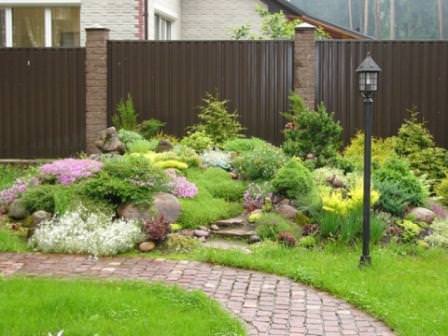
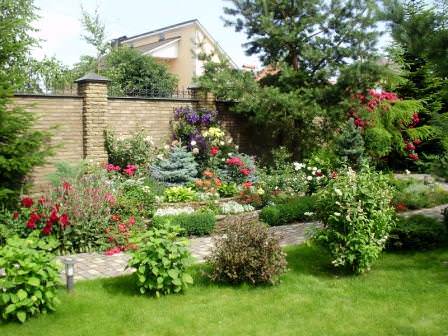
Choosing and preparing a place for a flower bed
The first step to creating a beautiful flower bed of roses is choosing the right place and providing a comfortable environment for the proud beauty.
Rose is a sun-loving plant, but the scorching midday heat is not good for her. Therefore, an ideal place for planting a rose garden will be a place illuminated by the sun in the morning and evening, and from about 12 to 15 o'clock there should be partial shade. In addition, it must be protected from strong winds and drafts. What can you do, queen ...
The rose is not particularly demanding for soils, light nutritious loams or black soil are preferred. The acidity is close to neutral.
An important point when planting roses is soil moisture. They do not tolerate the proximity of groundwater and excess moisture. Therefore, before planting, it is recommended to equip them with good drainage (crushed stone, gravel, expanded clay, coarse sand).
It is necessary to leave enough space between the bushes, taking into account the growth, because with a thickened planting, the risk of black spot on roses and other problems increases.

After choosing a place, you should not be lazy and, armed with pencils, draw an approximate diagram of the desired flower garden. This will allow you to avoid some mistakes later. You should not create complex intricate patterns in the rose garden, as well as get carried away with a large number of companion flowers. A rose is beautiful in itself; like a work of art, it only needs an unobtrusive frame.
The combination of roses by color and habit
To make your roses look spectacular and emphasize the dignity of each other, you should carefully consider the selection of colors.
A monochrome flower garden always looks noble and beautiful. Flower beds built on a contrast of color, for example, red with white or cream, look spectacular.
If you want to plant roses of various colors, then purple with yellow or orange, pink with blue tones go well. Purple and red roses will get lost against the background of each other, the combination of red and orange is also unfortunate, and cream flowers against the background of white can seem dirty.
Roses of variegated color are not combined with others and are always planted in a separate group.
On a green background of a lawn or ornamental shrubs, all roses look just great. And on the bare black ground, they will not look very attractive. It is necessary to plant low plants in between the bushes or sow grass. Mulching empty space with decorative chips or rubble will make the flower garden interesting.
Regarding placement in a flower bed, the same rules apply for roses as for other plants. Tall species are located in the background, then medium-sized and dwarf and ground cover closer to the edge. In a round flowerbed, tall roses are planted in the center, and then there is a uniform decrease in height.
In a flower garden, roses of the same variety should be planted in a group (at least 3 pieces), since a single bush will not be expressive enough.
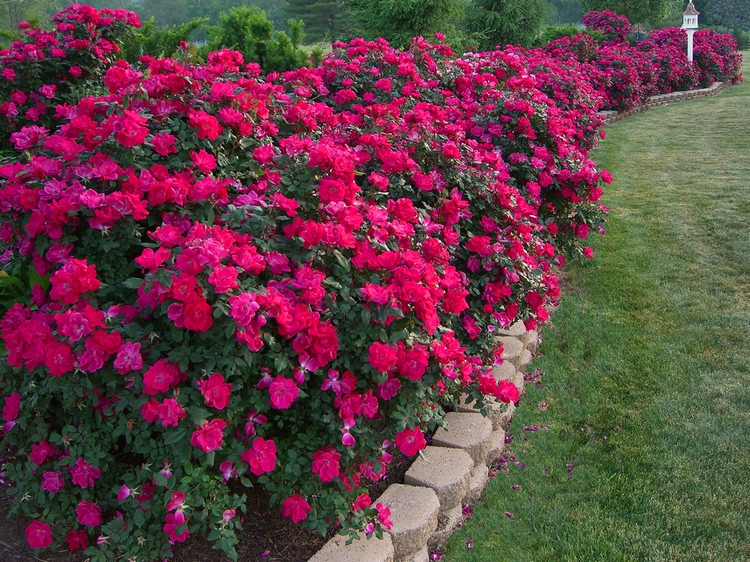
In order for the roses in the flowerbed to be beautiful and healthy, you should pay attention to the planting density. The gaps between the bushes should be sufficient for normal air circulation, but at the same time not create large voids
So, the interval between the bushes should be from 30 cm or more, depending on the height and species characteristics.
When planting roses near the walls of the house, you should step back from the edge of the blind area about 50 cm. The same indent should be made from the edge of the curb when placing roses along the path, since most of them have thorns and can cause inconvenience.
In order for your beautiful flower beds with roses to retain their splendor for the whole season, you should pay attention to the selection of varieties and by the timing of flowering. The choice here is very large and this will not be a problem.
When planning a pink flower garden, you can show creative imagination, however, even if the size of the site allows, you should not make them very large, this will complicate the care of the plants.
It will be useful to read:
Mixborders of perennials and annuals
Sometimes, looking around your garden, you realize that some flowers in a hurry were planted chaotically. And there is a desire ...
The location of the flower bed
An important role is played not only by what can be planted in the flower bed, but also by the site itself where the flower garden will be located.
First of all, the place should not be too humid. The plant does not tolerate stagnant water, stops growing and is affected by fungal diseases. It is best to place the flower bed on loamy soil with low or neutral acidity. If the soil is sandy, add a little nutritious soil mixture based on clay to each hole.
Figure 1. Location of flower beds on the site
In addition, humus, compost and mineral fertilizers must be added to the soil, but not fresh manure, as it can lead to the death of seedlings. It is also recommended to plant them in areas with light shading.
It is advisable to place the flower bed in an area protected from cold winds and drafts (Figure 1). The queen of flowers is very sensitive to cold, and even a small draft can destroy the seedlings.
From the video you will learn how to avoid common mistakes when arranging a flower bed.
Soil requirements
Particular attention should be paid to the choice of soil. As mentioned above, the culture does not like overly moist soil.In such conditions, rot begins to develop on the roots, and the culture gradually dies.
Loamy soils are considered the best, but it is also possible to create optimal soil conditions artificially. For this, a little sod or clay soil is introduced into the sandy soil. If the site consists mainly of clay, it is recommended to add some sand and peat to each hole when planting.
Ideally, the soil should allow moisture to pass through well, retaining a small amount for root nutrition. Regardless of the type of soil, when planting, the site must be fertilized with rotted manure and mineral dressings.

